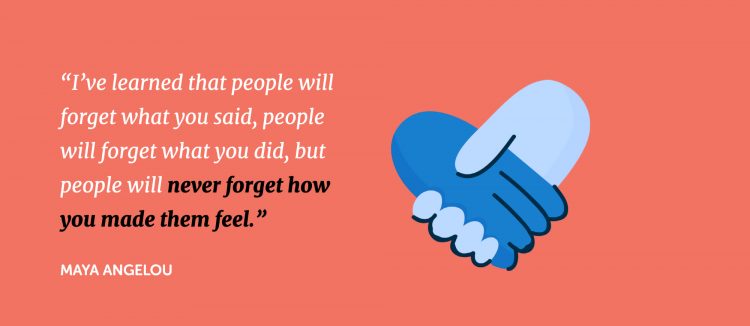5 Ways Neuroscience Helps Your Nonprofit Understand Donor Behavior

This donor behavior post is written by UNICEF’s senior coordinator and featured speaker at the 2021 Collaborative: Virtual Sessions, Francesco Ambrogetti. You’ll find features of the forthcoming book, Hooked on a feeling. How passion and devotion for good causes become memory and identity, published by Civil society press.
The COVID-19 pandemic emphasized (or accelerated) how emotions guide our decisions and shape our behavior. It’s directly correlated to the neuroscience of modern donor behavior.
For instance, fear now influences social interactions. During similar global crises, humanity responded with generosity, donating money or time to help others. Donor behavior continues to evolve just as we’ve seen in previous waves of activism and solidarity, such as Live Aid, the 2004 Tsunami, and the ALS Ice Bucket Challenge.
Now, we have to ask ourselves—how will donor behavior continue?
Can emotions go beyond igniting one-off donations and mobilizing people to participate in rallies to creating long-term supporters for nonprofit organizations?
The Power of Emotional Responses to Crisis
In April of 2019, a massive fire erupted in Paris, devastating Notre Dame. It’s one of the events that will be stamped in our memory forever. We all wanted to cry, show our pain, and offer a way to help.
Notre Dame received $1 billion pledged and more than $300 million raised in just a few days.
The paradox is that the response was too much and too late. Nicole Picaud, the senior fundraiser for Notre Dame, lamented that the organization received more than three times the amount of money they initially set out after. Donations only came after some of the features Notre Dame hoped to repair got destroyed.
The excess donations show the power of emotional responses, similar to the ones we see from donors in cases like the Australia fires or the Black Lives Matter movement.
Emotions as a Vital Element of Donor Behavior
When strong emotions like anger or fear are in play, driven by a story in the media, it’s difficult to predict the volume of donations a charitable cause requires. There’s also the consideration of how and when donors will contribute to support a cause.
Donors feel so strongly in these moments that many respond with donations in minutes and expect to see an immediate impact. Imagine a dollar transforming itself into justice or help, instantly and magically.
Nonprofit organizations must aim to shift the mindset of donors from opting for reactive donations to donating proactively to the world’s most important causes before a crisis or accident happens.
Are Donations Driven by Empathy or a Psychological Response?
The story of Notre Dame and the spectacular response it generated is a good illustration of the dilemmas donors face. Are emotions leading to more empathic and altruistic donor behavior, or are they a somewhat selfish response to a psychological need to feel better?
Donations of any kind are always going to benefit the missions of nonprofits everywhere. Still, the answer to this question could influence whether nonprofits should appeal to donors through extreme (and often negative) emotions.
Below, you’ll find the science to answer all of these questions.
The Neuroscience of Donor Behavior
Recent movements for social good could conclude that today’s generations of donors are more generous and charitable. The only way to understand what motivates an individual to give today and continue giving in the future is science.
Nonprofit organizations often measure fundraising results such as donation volume,engagement on social media, and participants at fundraising events without knowing why people take these actions. Tapping into the neuroscience of donor behavior helps you better predict if or how people will likely support your organization in the future.
Emotionraising, Explained
Emotionraising considers evidence and research from neuroscience, behavioral economics, and marketing and fundraising. It’s a concept that helps us understand how people move from pure awareness of a need to an act such as donating. Emotionraising is where neuroscience meets actionable advice for nonprofit organizations.
5 Quick Takeaways About the Neuroscience of Donor Behavior
1. Become the Answer to Negative Emotions
The mesolimbic part of the brain assigns values to the sensory stimuli, helping us classify what we feel. Donors can often make decisions based on how ideas match their concept of fear or sadness or how to resolve those concepts through positive action.
In other words, the decision to support a cause is not just pure instinctual action. Emotions are made, not only experienced. For example, our experience of fear or discomfort is a subconscious simulation of the appropriate way to react consciously.
Nonprofits have an opportunity to present their cause as the hope and possibility that counteracts negative emotions. Tapping into the desire for action in your donors by presenting your work and impact will encourage them to support fundraising efforts that make change possible.
2. Understand Donor Values
The rational part of a donor’s brain still mediates the action evoked or prompted by the emotional part through values and learnings. Emotions are fundamental to get donor attention and prompt actions. However, each individual still needs to recognize those emotions and assign a value to them to translate them into action.
An example of this type of decision-making would be how individuals react to an email prompting them to give to a local animal shelter. Suppose that individual recently adopted a new pet. In that case, they may assign a higher value to the emotion of love for animals and give right away.
If that same individual has a sick relative, everything can change. They may not associate a high emotional value to the animal shelter the way that they would if the cause were closer to their emotions of worry or empathy for other humans.
3. Remind Donor Why They Give
Donors are being pulled or pushed by powerful emotions and neurotransmitters released by our brain as they attribute a value to them. When a donor responds to emotions, the brain releases volatile power chemicals.
Donors feel better through actions like donating and then often move on. Most people may forget, and many do not even remember supporting an organization when asked why they do not donate anymore. Keep your cause top of mind for supporters through regular communication to positively influence their decision to continue contributing.
4. Hook Donors on a Feeling
Emotions are made and formed, anticipated and created, and stored in a memory to become a feeling. Understanding how emotions in your donors become a more conscious part of the giving experience is critical.
Tapping into the right donor feelings is how your nonprofit can more effectively solicit and ignite individuals to support without asking or demanding. It’s all about how you can make people fall in love with your cause without pressure.
The issue is not prompting or tempting more people to support your cause but hook them on a feeling. Present your values and identities that support an internal feeling that makes sense for each donor and the communities to which they belong. Consider how your mission can help this critical connection.
5. Build Donor Loyalty
Why are people more loyal to specific life experiences than others? Why do some individuals choose to buy a pair of sneakers, take a trip, or watch football over donating to nonprofits?
We are not loyal by nature or by habit, but by choice.
Our brain releases complex and long-term reward mechanisms from the same area that regulates the formation and storage of memory. A loyal or engaged customer, art lover, or football fan has memory elements that contribute to releasing subconsciously powerful feel-good chemicals.
Those chemicals reinforce a person’s sense of belonging and engagement with their team or a product they bought. Elements related to memorable experiences define the identity and behavior of donors beyond the initial emotional engagement of donating.
You Already Have What It Takes
The takeaways above show us that donors are no different than everyday individuals taking action based on strong emotion or feeling.
You are in the position to guide those actions in the best direction to make an impact. All it takes is presenting your cause in a way that appeals to emotions and feelings at every step of your donor’s experience.
It’s more important than ever to apply neuroscience and behavioral economics to your marketing and fundraising. A deep understanding of donor behavior will better position you to grow a lasting connection that fuels loyalty through your recurring giving program.
If there is one thing to look for in the post-COVID-19 world, it’s the magic of Maya Angelou’s words:

Meet Francesco at the Collaborative: Virtual Sessions

There’s a lot more to dig into on the topic of donor behavior, so we’re bringing the conversation to our completely free nonprofit event, the Collaborative: Virtual Sessions.
Register to hear Francesco Ambrogetti’s signature session alongside so many other experts in the nonprofit sector as we encourage collaboration, meaningful connections, and insights to accelerate your organization’s impact.

Hear What the Future of Fundraising Holds




